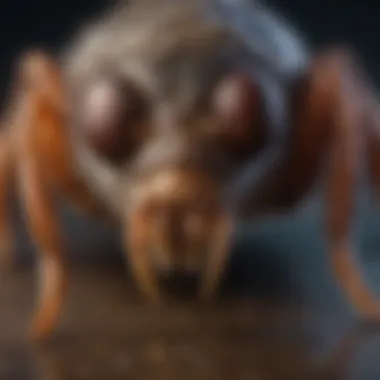Comprehensive Guide to Extermination Services in Boulder


Intro
Extermination services play a critical role in maintaining the livability and health of homes and businesses in Boulder, Colorado. The city's unique environment makes it susceptible to various pests, which can lead to significant problems if left unchecked. Awareness of the specific pests affecting Boulder and understanding the methods of control can empower homeowners to make informed decisions about pest management.
With the increase in environmental concerns, pest control is not just about eliminating critters but also about doing so in a manner that minimizes harm to the ecosystem. This article explores the multifaceted approach required for effective extermination services, offering insights into pest identification, prevention strategies, and control methods.
Understanding the Pest
Identification
Identifying pests is the first step toward effective extermination. Common nuisances in Boulder include ants, spiders, mosquitoes, and rodents. Each of these pests has its own unique traits, habitat preferences, and behaviors. For instance, ants often form colonies and can invade kitchens searching for food. Recognizing the signs of an infestation, such as droppings or nesting materials, is crucial for early intervention.
Life Cycle
Understanding the life cycle of a pest can aid in controlling its population. Most pests have distinct stages: egg, larva, pupa, and adult. For example, mosquitoes breed in stagnant water. A thorough understanding of their life cycle can inform management strategies. Eliminating breeding sites can significantly reduce the likelihood of an infestation.
Pest Prevention Strategies
Environment Modification
Modifying the environment is a proactive approach to pest control. This can include regular landscaping maintenance, sealing cracks and openings in structures, and ensuring proper waste management. Cleaning up clutter minimizes hiding spots for pests.
Physical Barriers
Physical barriers, such as screens on windows and doors, can be effective in preventing pest entry. Installing weather stripping can make a significant difference in reducing pest access. Regular maintenance of these barriers is essential for keeping pests at bay.
Control Methods
Chemical Control
Chemical control methods involve the use of pesticides to eliminate pests. While effective, these should be used sparingly and only when necessary, due to potential ecological impacts. Homeowners should consider professional extermination services that use targeted chemicals that are effective yet eco-friendly.
Biological Control
Biological control utilizes natural predators to manage pest populations. For example, introducing ladybugs can help control aphid populations. This method aligns with a sustainable approach to pest management, allowing for a harmony between pest control and environmental health.
"Effective pest management combines prevention, identification, and a deep understanding of the ecosystem.”
Overview of Pest Control in Boulder
Pest control in Boulder, Colorado is a crucial topic for house owners and residents alike. This region faces unique challenges due to its varying climates, landscapes, and ecological diversity. Understanding pest control helps homeowners effectively manage and mitigate infestations that could potentially harm their property and health. Aquiring knowledge about pest management not only empowers residents to act but also fosters a safer living environment for families.
Effective pest control involves identifying common pests, understanding their behaviors, and implementing suitable extermination techniques. Moreover, an awareness of pest control services can greatly influence how residents approach pest problems. With the guidance of this overview, property owners can make informed decisions that prioritize effectiveness while considering environmental impacts.
Historical Context of Pest Management
The history of pest management in Boulder reflects broader trends seen across the United States. Initially, pest control largely relied on rudimentary methods that prioritized immediate eradication. As urbanization grew, Boulder saw the rise of chemical pesticides in the mid-20th century. These substances promised quick solutions but later revealed detrimental effects on both health and the environment. Over time, public awareness shifted towards more sustainable practices.
Modern pest management in Boulder involves a blend of traditional methods and innovative techniques, responding to the complex interrelationships in local ecosystems. Understanding the historical context allows today’s homeowners to appreciate the evolution in pest control approaches. It offers insights into why certain methods are preferred now and how regulations have developed.
Current Trends and Challenges
Today, pest control in Boulder faces several notable trends and challenges. One prevailing trend is the increasing emphasis on Integrated Pest Management (IPM). This approach combines biological, cultural, and chemical tactics to minimize ecological disruption while effectively addressing infestations. Homeowners now prioritize eco-friendly options that preserve biodiversity.
However, challenges persist. The rise of resistant pests, worsened by overreliance on chemical treatments, has created complications for effective management. Additionally, changing weather patterns influence pest behavior, making them more unpredictable and harder to manage.
"Awareness of current trends in pest control can lead to better pest management strategies and healthier homes."
Consequently, Boulder residents must stay informed. Recognizing both the trends and challenges of pest control not only ensures more effective outcomes but also contributes to long-term environmental responsibility.
Common Pests in Boulder


Understanding the pests prevalent in Boulder is crucial for effective pest control. Recognizing common pests helps in early detection, which is vital for preventing infestations. It can save time, money, and emotional stress for homeowners by promoting prompt action. This section also highlights the importance of knowledge regarding the local ecological balance and how specific pests can impact it.
Identification of Invasive Species
Invasive species pose significant threats to local ecosystems. In Boulder, common invasive pests include species like the Bark Beetle and Japanese Beetle. Identifying these pests early on is critical. Homeowners can look for specific signs, such as damage to trees, noticeable holes in leaves, or changes to soil composition. The method of identification may involve:
- Physical Examination: Inspecting plants and structures for visible damage.
- Monitoring Tools: Using traps or pheromones can help detect their presence.
- Local Resources: Consulting guides or local pest control services for identification resources.
Identifying invasive pests early not only helps in minimizing damage to property but also aids in protecting local flora and fauna.
Behavioral Patterns and Habitats
Understanding the behavioral patterns and habitats of common pests is vital for effective pest control. Different pests thrive in various environments, making it critical for homeowners to know where these insects usually reside. For instance:
- Cockroaches often prefer warm, moist areas. Basements and kitchens are common hotspots.
- Ants, particularly species like the Argentine Ant, are attracted to food sources. They often build nests in soil or inside homes, near food residue.
- Rodents, such as mice, tend to settle in quiet, sheltered locations. They favor attics, basements, or gaps in siding.
Knowing the behaviors and preferred habitats of these pests also allows for targeted pest management strategies. For example, adjusting landscaping practices or improving food storage can effectively deter pests.
Identifying, understanding, and controlling pest behavior is not only beneficial for maintaining property but also essential for enhancing overall community health.
Extermination Techniques
Understanding extermination techniques is crucial for homeowners in Boulder, Colorado, who seek effective pest management solutions. These methods vary widely and directly impact their success in eliminating pests while maintaining an ecological balance. By selecting the appropriate technique, homeowners can not only protect their properties but also contribute to the sustainability of the environment.
Chemical Methods
Types of Insecticides
Types of insecticides play a vital role in pest control. There are several categories, including pyrethroids, neonicotinoids, and botanical insecticides. Each type has its own mechanism of action and targets specific pest species. Pyrethroids, for example, are synthetics modeled after natural insecticides found in chrysanthemum flowers, making them a popular choice due to their fast-acting properties. However, pesticide misuse can lead to resistance, which is a disadvantage.
Application Techniques
Application techniques significantly influence the effectiveness of extermination methods. There are various ways to apply insecticides, including sprays, granular applications, and fogging. Sprays offer targeted delivery, allowing for precise treatment in affected areas, which minimizes exposure to non-target organisms. However, improper application can lead to runoff and contamination of desirable plants.
Safety Considerations
Safety considerations are paramount when using chemical methods for pest control. Homeowners should be aware of the potential health effects on humans and pets. Using insecticides according to recommended guidelines reduces risks. Proper personal protective equipment, such as gloves and masks, is essential during application. To enhance safety, opting for lower-risk products can also be a practical approach.
Biological Control
Beneficial Insects
Beneficial insects are a natural solution to pest problems. These helpful allies include ladybugs and lacewings, which feed on common pests like aphids and mites. Employing beneficial insects adds ecological value and reduces reliance on chemicals. One major advantage is their self-sustaining nature, meaning they can establish populations that continue to control pests over time.
Microbial Agents
Microbial agents, such as bacteria, fungi, and viruses, offer options for collaborative pest management. Bacillus thuringiensis (Bt) is a well-known microbial insecticide that specifically affects caterpillars. Their specificity is a significant advantage because it minimizes harm to beneficial insects and non-target species. However, they may require precise application conditions to be effective, which can be challenging.
Integrated Pest Management (IPM)
Principles of IPM
The principles of Integrated Pest Management encompass a holistic approach to pest control. IPM combines biological, cultural, physical, and chemical strategies to prevent and manage pest populations. This comprehensive methodology reduces the use of chemicals, promoting a balanced ecosystem. Homeowners find it beneficial because it addresses the root causes of pest problems rather than merely treating symptoms.
Case Studies in Boulder
Case studies in Boulder illustrate the successful implementation of IPM strategies. Local pest control companies often share examples where ecological balance was restored through proper habitat management, crop rotation, and pest monitoring. These case studies highlight the effectiveness of IPM, encouraging homeowners to consider this sustainable framework for enduring pest management solutions.
Professional Extermination Services
Professional extermination services play a crucial role in managing pest control effectively. The importance lies in the expertise and experience that trained professionals bring to the table. They understand the complexities of pest behavior and the various methods available to address infestation issues. Moreover, using professional services can save homeowners time and reduce stress, especially when infestations escalate beyond manageable levels.


By employing specialized techniques and tools, exterminators can target pests more effectively than standard household remedies. This involves not just eliminating pests but also assessing and addressing the conditions that allow them to thrive. A well-rounded approach is vital for long-term pest management. Homeowners often prefer professional services because of their thoroughness and the reliability they offer, ensuring that the problem is addressed comprehensively.
Choosing a Pest Control Company
Choosing the right pest control company is essential for effective extermination services. The decision can impact the success of the pest management strategy employed in a home.
Certification and Licensing
Certifications and licensing are pivotal aspects to consider when selecting a pest control service. These credentials signify that a company adheres to industry standards and regulations. Licensed exterminators are mandated to follow specific guidelines, which can significantly enhance the quality of service provided.
A key characteristic of certification is the continuous education requirement for professionals in this field. This means they stay updated on the latest strategies and pesticide regulations, which is beneficial for homeowners seeking effective and safe solutions. Moreover, certification often serves as a guarantee of professionalism and knowledge, instilling confidence in potential clients.
However, it is crucial to verify the legitimacy of the certifications by checking with state regulatory agencies or local authorities. Some companies may claim certifications that are not up-to-date or legitimate, which poses a risk to homeowners. Thus, ensuring that the company both holds valid licenses and has a good standing in the community can help in making an informed choice.
Customer Reviews and Testimonials
Customer reviews and testimonials are significant indicators of a pest control company's credibility. They provide insight into the experiences of previous clients, making them a reliable tool for evaluation. Positive reviews can highlight the effectiveness of services, customer service quality, and the overall satisfaction of clients.
One unique feature of testimonials is that they often reflect not just the results but the entire client experience, which is vital for new customers to understand. A company that consistently receives favorable feedback tends to build a strong reputation in the local community, making it a preferred choice for homeowners needing extermination services.
However, while testimonials can be helpful, they should not be the sole factor in decision-making. It is essential to consider a range of reviews to get a complete picture of a company's reliability and effectiveness. Additionally, look for patterns in reviews regarding certain pest control methods or customer service practices, as these can provide deeper insight into what to expect.
Evaluating Service Packages
Evaluating service packages is key when selecting pest control services. Different companies offer various levels of service, and it is important to align these packages with your specific needs. Some may provide basic preventive treatments, while others offer comprehensive plans that include regular inspections.
Consider the following aspects when evaluating service packages:
- Frequency of Service: How often do they provide treatments?
- Methods of Control: What techniques do they use? Are they traditional, eco-friendly, or a combination?
- Guarantees Offered: What warranties or guarantees come with the service?
- Emergency Services: Is there a provision for urgent pest issues?
Taking the time to review these factors helps ensure that the chosen package effectively addresses your concerns and fits your budget.
DIY Pest Control Solutions
DIY pest control solutions play a vital role in the broader conversation about pest management, particularly for homeowners seeking cost-effective and immediate options. These methods can empower individuals to take charge of their pest problems while fostering a better understanding of the pests they face. The landscape of pest control often finds homeowners caught between professional services and DIY methods. Each has its merits, yet the allure of DIY solutions often lies in their accessibility and resourcefulness.
There is a growing trend among homeowners in Boulder to seek out do-it-yourself pest control techniques. They appreciate the autonomy and hands-on approach that DIY solutions provide. Moreover, using household items offers a level of convenience that professional services may not always guarantee, such as immediate application when a pest threat arises.
However, understanding the limitations and potential risks is crucial. Not all pests can be effectively managed through DIY methods, and improper applications can lead to larger infestations or environmental damage. Thus, it is important to approach DIY pest control with a well-informed perspective.
Common Household Remedies
When considering common household remedies, individuals often turn to readily available ingredients that can be both effective and safe. Some of the most popular remedies include:
- Vinegar: This is often used to deter ants and spiders. A mixture of vinegar and water can be sprayed around entry points.
- Boric Acid: This is particularly useful for cockroach control. When mixed with sugar, it can attract roaches while simultaneously introducing a lethal poison.
- Essential Oils: Oils such as peppermint and tea tree can repel rodents and insects when diluted and sprayed in affected areas.
- Diatomaceous Earth: This natural pesticide works by dehydrating pests such as fleas and bed bugs. Sprinkling it around infested areas can offer substantial help.
- Soap Solutions: Using liquid soap mixed with water can help suffocate soft-bodied insects like aphids and mites.
Utilizing these remedies correctly is essential. Homeowners should remember to conduct patch tests to ensure no harm comes to pets or surfaces in the home.
Advantages and Limitations
The advantages of DIY pest control solutions are clear:
- Cost-Effective: These methods often require minimal financial investment compared to hiring professionals.
- Immediate Action: Homeowners can act as soon as they identify a pest problem.
- Availability: Common household items are usually easy to find and use without needing special training.
However, there are limitations to consider:
- Efectiveness: Some pests may be resistant to common remedies, necessitating professional assistance.
- Safety Concerns: Improper usage of certain substances can pose risks to humans and pets alike.
- Time-Consuming: Effective pest control may require multiple applications, becoming tedious for some individuals.
It is vital for homeowners to weigh both advantages and limitations when choosing DIY pest control methods, ensuring they make informed and responsible decisions.
In summary, DIY pest control solutions are a significant area in pest management that can benefit many homeowners in Boulder. While these methods offer practical benefits, understanding their limitations is essential.


Ecological Impact of Pest Control
The topic of ecological impact of pest control is critical for understanding how pest management practices influence the environment. This section will explore significant elements that relate to pest control, focusing on benefits and considerations.
Environmental Concerns
The use of pesticides and extermination methods can lead to various environmental concerns. The persistence of chemicals in ecosystems can harm non-target species, including beneficial insects and aquatic systems. For instance, runoff from treated areas can contaminate water sources, posing risks to wildlife and potentially affecting human health.
Most importantly, the bioaccumulation of toxins may lead to long-lasting effects on the food chain. Animals higher up in the chain often consume these chemicals, which can affect their health and reproductive success. Homeowners must be aware of these implications when considering pest control options.
"Understanding the ecological impact of pest control allows for more informed decisions, balancing the urgency of pest management with environmental health."
Furthermore, soil health can be compromised through the repeated application of certain pesticides. Beneficial microorganisms essential for nutrient cycling might be affected, leading to a decline in soil fertility over time. This could have implications not only for gardens and lawns but also for broader agricultural practices in the region.
Sustainable Practices in Boulder
In Boulder, there is an increasing movement toward sustainable pest control practices that mitigate ecological harm. These practices often prioritize methods such as Integrated Pest Management (IPM), which emphasizes long-term prevention and utilizes a combination of biological, cultural, and mechanical control methods.
Local exterminators may offer organic solutions, using naturally derived products that are less harmful to the environment. Homeowners can engage in practices like encouraging natural predators of pests, such as birds and beneficial insects, instead of relying solely on chemical treatments.
Common sustainable practices include:
- Mulching: Helps suppress weeds and retains moisture, reducing the need for chemical herbicides.
- Diversity in Planting: Mixing different plant types can deter pests and promote a balanced ecosystem.
- Regular Monitoring: Keeping track of pest activity can lead to early intervention without widespread chemical application.
By implementing these methods, residents of Boulder can contribute to a healthier environment while effectively managing pest issues. The goals of sustainable pest control include not only achieving pest reduction but also enhancing biodiversity and protecting local ecosystems.
Regulatory Framework
Understanding the regulatory framework surrounding pest control in Boulder is essential for both residents and pest management professionals. These regulations are designed to protect public health, ensure environmental safety, and maintain community standards. By comprehending these rules, homeowners can make informed choices that align with legal requirements while effectively addressing their pest issues.
Additionally, awareness of regulations helps in selecting qualified pest control services. Companies must adhere to state and local laws when applying pesticides or implementing pest management strategies. This ensures that pest control measures are not only effective but also safe and environmentally responsible.
State Regulations Regarding Pesticides
In Colorado, state regulations play a critical role in managing the use of pesticides. The Colorado Department of Agriculture oversees the registration and usage of pesticides within the state. This includes:
- Pesticide Registration: All pesticides used in Boulder must be registered with the state. This process ensures that only products deemed safe and effective are available for use.
- Labeling Requirements: Pesticides must be labeled correctly to inform users about their safe application. Labels include information on active ingredients, proper usage, and safety precautions.
- Applicator Licensing: Professionals applying pesticides must hold a valid license issued by the state. This requirement ensures that applicators are trained in safe and effective pest control practices.
These regulations aim to minimize the health risks associated with pesticide exposure while promoting sustainable pest management practices.
Local Ordinances Related to Pest Control
Boulder's local ordinances complement state regulations by addressing specific community concerns and environmental considerations. Key local ordinances include:
- Pesticide Use Restrictions: Certain pesticides may have restrictions in residential areas. Homeowners should be aware of these restrictions to avoid unintentional violations.
- Notification Requirements: Some ordinances may require pest control companies to notify residents before applying certain pesticides. This practice ensures transparency and helps residents make informed decisions regarding their environment.
- Integrated Pest Management (IPM) Encouragement: Local authorities promote IPM practices that prioritize non-chemical pest control methods. This approach aligns with ecological sustainability and reduces reliance on chemical solutions.
Local ordinances are specially designed to reflect the unique environmental needs of Boulder, making community engagement a vital part of pest management.
By understanding both state regulations and local ordinances, Boulder residents can navigate the pest control landscape more effectively, ensuring compliance, fostering safety, and protecting the environment.
Future of Pest Control in Boulder
The future of pest control in Boulder carries significant implications for both residents and the ecological landscape of the area. As the field evolves, new technologies and methodologies emerge, influencing how pest management is approached. Homeowners in Boulder will benefit from understanding these developments, as they can lead to more effective, accurate, and environmentally responsible pest management solutions. This is particularly critical given the unique ecosystem of the region and the various invasive species that pose a risk.
Emerging Technologies
Emerging technologies are reshaping the pest control industry. Innovations in pest detection, such as remote sensing and drone technology, allow pest control professionals to gather data in real-time. For instance, drones can monitor landscapes and identify pest hotspots that may not be visible from the ground. This can lead to targeted interventions, reducing the use of chemicals and enhancing the overall effectiveness of pest control efforts.
Biopesticides, derived from natural materials, are gaining popularity, providing effective pest mitigation while also being safer for the environment. These biopesticides can be used in conjunction with traditional methods to minimize ecological impact, sealing a sustainable path forward for pest management. Furthermore, developments in genetic research are opening avenues for controlling pest populations through biological means, which may offer long-term solutions to certain pest issues.
Predictive Analytics in Pest Management
Predictive analytics is revolutionizing how pest control companies approach their work. By analyzing data patterns and environmental conditions, pest control experts can forecast pest outbreaks and take proactive measures. This forward-thinking approach allows companies to plan interventions based on predicted trends rather than reacting to existing infestations.
Homeowners in Boulder should be aware of these advancements, as they can significantly reduce the costs associated with pest management and improve outcomes. For instance, knowing when certain pests are more likely to appear can facilitate early treatments that mitigate larger infestations.
In summary, the future of pest control in Boulder is characterized by technological innovation and a shift towards more proactive and environmentally friendly strategies. Understanding these changes will empower homeowners to engage effectively with pest management services, ensuring their homes remain pest-free while supporting ecological health.







